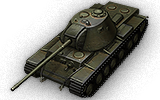Select your region to log in.
Crew:
- Commander
- Radio Operator
- Driver
- Gunner
- Loader
- Loader
Advantages:
- Good all-around armour, really tough when angled
- High alpha damage with the 122 mm cannon and above-average DPM
- Great at sidescraping
- Well sloped Turret armour with auto bounce sides
- Good max speed for its size (V-2SN engine)
Disadvantages:
- Armor is very flat, vulnerable to T8-9 guns
- Low accuracy and sluggish behaviour. The gun mantlet is very weak on the center.
- Atrocious aiming time (3.4 seconds)
- Side of the turret and hull have massive module hitboxes
- Limited penetration, even with APCR
Tank description:
The KV-3 is a Soviet tier 7 heavy tank.Developed on the basis of the KV heavy tank, the vehicle initially had very few differences from the mass-produced model. It underwent field trials in January–February 1941. Eventually, several crucial changes were made to the design, greatly boosting the combat characteristics of the vehicle. By July 22, 1941, chassis and engine development was completed. According to some sources, in the fall of 1941, the vehicle was equipped with a serial KV turret and sent to the front.The KV-3 is defined by its lengthened and more heavily armoured KV chassis, and a much rounder turret design. It can use a large variety of guns, but it''s best known for the 122mm D-25T cannon, a weapon it shares with the IS. It sports an impressive 120mm of frontal hull armour, its turret is relatively well-armoured too, and the conical design makes bouncing frequent. When upgraded, it can mount the V-2SN engine, which gives a huge boost of horsepower. It is however much slower than the IS, and like the IS it lacks penetration compared to the German, French and US heavy tanks of its tier.The KV-3 leads to the KV-4, and the IS-2-II.
Developed on the basis of the KV heavy tank, the vehicle initially had very few differences from the mass-produced model. It underwent field trials in January–February 1941. Eventually, several crucial changes were made to the design, greatly boosting the combat characteristics of the vehicle. By July 22, 1941, chassis and engine development was completed. According to some sources, in the fall of 1941, the vehicle was equipped with a serial KV turret and sent to the front.

 Русский
Русский English
English Russian region
Russian region North-american region
North-american region European region
European region Asia region
Asia region Korean region
Korean region


 34 000
34 000
 880 000
880 000




